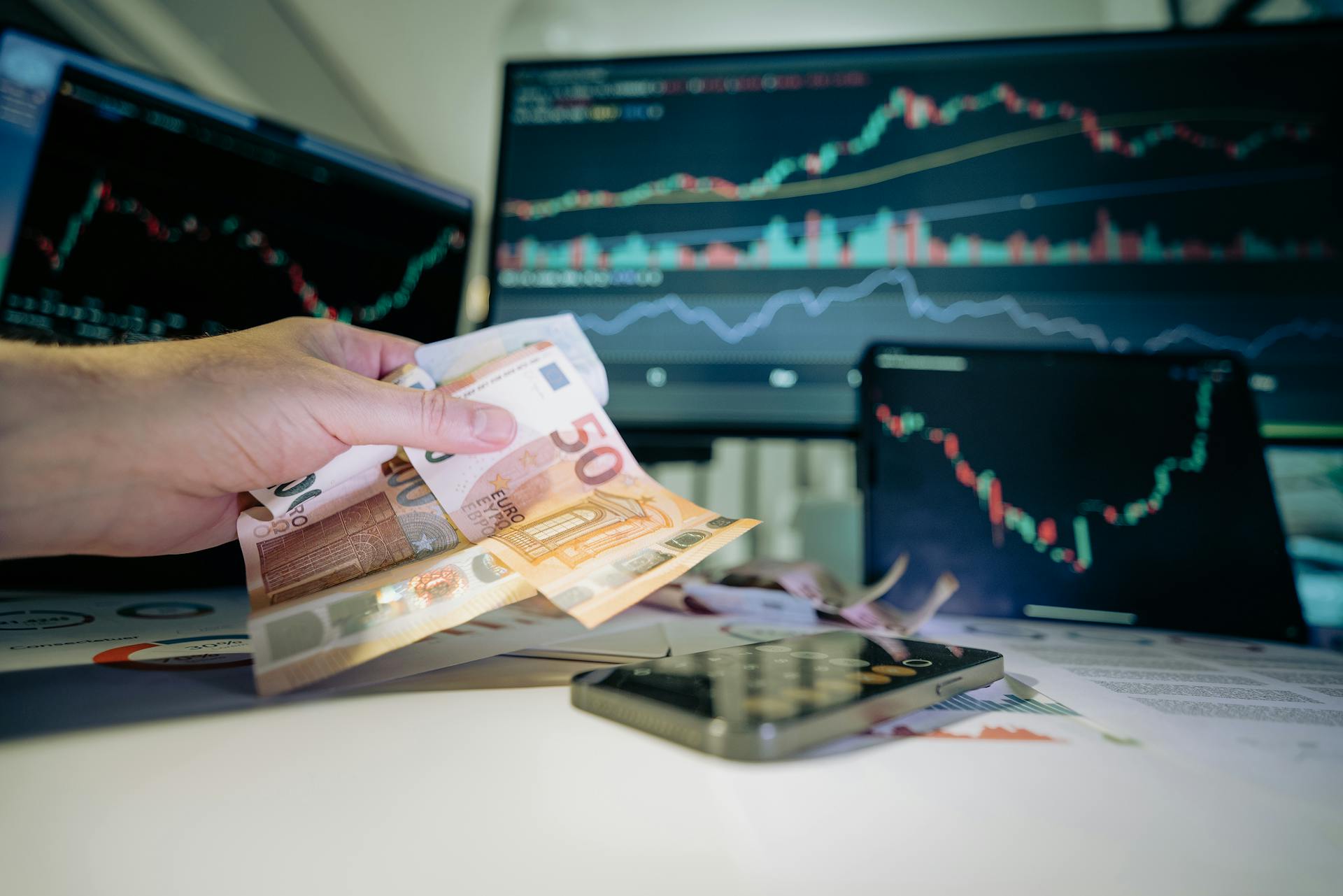
The currency carry trade strategy is a simple yet powerful way to generate returns in the foreign exchange market. It's based on the idea that borrowing in a low-interest-rate currency and investing in a high-interest-rate currency can be a profitable move.
The carry trade strategy involves borrowing in a currency with a low interest rate, such as the Japanese yen, and investing in a currency with a high interest rate, like the Australian dollar. This creates a positive carry, or interest rate differential, that can be used to generate returns.
To execute a carry trade, you'll need to open a position in the high-interest-rate currency and a corresponding position in the low-interest-rate currency. This can be done through a variety of financial instruments, including currency futures and options.
The key to success in a carry trade is to maintain a long position in the high-interest-rate currency and a short position in the low-interest-rate currency, allowing you to capture the interest rate differential and generate returns.
For more insights, see: Position Trading
What Is Currency Carry Trade?
A carry trade strategy involves borrowing at a low interest rate from one currency and investing in an asset that provides a higher rate of return in another currency.
This kind of trade can be profitable, but it's not without risks, which include a sharp decline in the price of the invested assets.
The invested assets could be certificates of deposits, stocks, commodities, bonds, or real estate, denominated in the second currency.
Investors with deep pockets are often the ones who attempt carry trades, as they can afford to take on the associated risks.
Exchange risk, or currency risk, is another risk involved when carrying trades involve two different currencies.
Trading Strategy Basics
A currency carry trade strategy involves borrowing in a currency with a low interest rate and lending in a currency with a higher interest rate. This strategy can be implemented by buying a currency pair where the interest rate differential is in favor of the currency being borrowed.
The key components of a carry trade include borrowing a currency with a low interest rate, converting the funds to a currency with a higher interest rate, and earning interest on the investment. The profitability of carry trades depends on stable or appreciating exchange rates in the high-interest-rate currency.
A common way to calculate the potential return of a carry trade is by using the formula: Potential Return = (Investment Amount * Interest Rate Differential) * Leverage. Leverage can significantly impact the potential gains of a carry trade, with some forex brokers offering leverage as high as 300:1.
Investors often favor carry trades because they earn interest revenue even if the currency pair doesn’t move. Currency rates constantly fluctuate, but a carry trader would be paid the rate differential even if their chosen pair didn’t move a single pip.
Here are some common currencies used in carry trades:
- New Zealand and Australia often have the highest yields.
- Japan has historically been a popular funding currency due to Japan's long-standing low-interest rates.
- Currencies like the Australian dollar have attracted investors on the receiving end of the trade.
The carry trade strategy can be implemented using a variety of currencies, but it's essential to consider the risks involved, including adverse exchange rate movements that can erode profits.
Choosing the Right Pair
The choice of currency pair is critical in carry trading, so don't rush into it. Investors must consider not only the interest rate differential but also the stability and liquidity of the chosen currencies.
Currencies from economically stable countries with transparent monetary policies are typically preferred, as they offer a balance of high returns and manageable risk. This is because they tend to have lower risk and more stable exchange rates.
Factors such as inflation rates, unemployment levels, and GDP growth can impact the stability and performance of the currencies. It's essential to conduct thorough research on the economic conditions of the countries involved.
The cost of borrowing and transaction costs can also influence the selection process, as these expenses can diminish the net return on carry trades. Make sure to factor these costs into your decision.
A failure of one currency pair won't result in a wipeout of your entire portfolio if you diversify your portfolio. This is the preferred way of trading carry for investment banks and hedge funds.
Intriguing read: Forex Currency Trading Live
Risk Management
Effective risk management is crucial when executing a currency carry trade strategy. You can set stop-loss orders to mitigate losses in the event of adverse currency movements. This can help protect your investments against market reversals.
To manage the carry trade, it's essential to establish clear risk management strategies, including setting risk tolerance levels and diversifying investments across different asset classes. Regularly reviewing and adjusting trading positions based on market conditions can also help minimize potential losses.
Here are some key risk management strategies to consider:
By implementing these risk management strategies, you can safeguard your portfolio against unexpected events and minimize potential losses.
Transaction Fees and Spreads
Transaction fees and spreads can significantly impact your trading gains. Wider spreads, particularly in less liquid forex pairs, can increase the cost of entering and exiting positions.
Transaction fees can reduce the overall gains of an operation. These costs are the differences between the buying and selling prices of a forex pair.
A trader must carefully monitor market movements, transaction costs, and swap rates in a carry position. This involves borrowing in a low-interest-rate currency and converting the funds to a higher-yielding one.
A fresh viewpoint: Live Currency Market News
A Key Risk
Carry trade unwinding can be a major risk for traders, as it can trigger rapid and significant price movements. This can lead to a much lower return if the exit is timed incorrectly.
Unwinding happens when traders begin to exit their positions en masse, often due to changes in market conditions, such as increased volatility or a shift in risk sentiment. This can cause a swift exit from carry positions and a steep decline in the investment currency.
For example, if global markets face uncertainty or economic data points to a weakening economy, investors may seek so-called safer assets, leading to a swift exit from carry positions and a steep decline in the investment currency.
This type of strategy offers a way to take advantage of interest rate differentials between currencies, but it comes with its own set of risks. Understanding the mechanics and analysing opportunities is critical.
Here are some key statistics on carry trade unwinding:
- 45% sell-off in currency pairs such as the AUD/JPY and NZD/JPY in 2008 was triggered by the subprime crisis that turned into the global financial crisis.
- The actual losses were probably much greater due to the use of leverage.
Benefits and Profitability
The benefits of a currency carry trade strategy are numerous. You can profit from the difference in two countries' interest rates, as long as the exchange rate between the currencies doesn't change significantly.
Investors earn interest on the currency pair held in a foreign exchange carry trade. This can be a long-term strategy, far more suitable for investors than traders, who will hold their positions for months if not for years at a time.
You'll earn the capital appreciation in addition to interest if the pair moves in your favor. However, you'll recognize a capital loss if the pair moves adversely.
A positive carry trade occurs when the borrowing rate on the investment currency is higher than that of the funding one. For example, if a trader borrows in Japanese yen (JPY) at 0.5% and invests in Australian dollars (AUD) at 4.5%, the differential is 4%.
The strategy generally involves using leverage to magnify any potential returns. Even the use of five- to 10-times leverage can make a return extremely extravagant in a market where leverage runs as high as 200:1.
On a similar theme: Fiat Currency Exchange Trading
Here are some key statistics on the performance of a carry trade strategy:
The returns on straight carry trades aren't very large for most people, but these trades are often executed with leverage. This makes a return extremely extravagant in a market where leverage runs as high as 200:1.
Strategy Considerations
The carry trade strategy can be a profitable way to invest in the foreign exchange market, but it's essential to consider a few key factors before diving in. The strategy's performance can be affected by the use of leverage, with even a small amount of leverage making a significant difference in returns.
Investors favor carry trades because they can earn interest revenue even if the currency pair doesn't move, and the use of leverage can amplify returns. A decent return can be achieved even with different settings, as seen in the backtest results.
To make informed decisions, investors must stay up-to-date on central bank announcements, economic indicators, and other factors that influence interest rates and currency values. This thorough analysis can provide valuable insights into future market movements and help select optimal currencies for carry trades.
Expand your knowledge: Day Trading Currency
A good example of the strategy's potential is shown in the backtest results, where both the carry trade strategy and the carry trade strategy with a filter made profits, while the forex pair went flat. The following table shows the returns and performance matrices:
Investors can also hedge their position by purchasing options to limit potential losses.
Strategic Considerations
Understanding the intricacies of interest rate forecasts can enhance the decision-making process for carry trades.
Interest rate forecasts are crucial because they can significantly impact the attractiveness of a carry trade.
Currency market trends also play a vital role in carry trade strategies, and staying informed about these trends can help investors make more informed decisions.
Political instability can lead to currency volatility, affecting the risk-reward profile of carry trades.
Understanding the regulatory environment in both the funding and target currency countries is essential to mitigate potential risks.
Investors must remain vigilant and incorporate geopolitical analysis into their strategic planning to stay ahead of potential risks.
Economic Indicators
Economic indicators like inflation rates, GDP growth, and employment figures can influence central banks' decisions on interest rates. A strong economy may lead to higher borrowing costs, making a pair more attractive for a yield differential position.
Investors must stay on top of these indicators to make informed decisions about carry trades. A thorough analysis of economic data can provide valuable insights into future market movements.
Monitoring inflation rates is crucial, as high inflation can lead to higher interest rates and a more attractive currency for carry trades. On the other hand, low inflation can signal a decrease in interest rates, making the currency less appealing.
GDP growth and employment figures are also essential indicators, as strong economic performance can signal stable or increasing interest rates, making their currencies more attractive for carry trades. Conversely, weak economic data can result in rate cuts, reducing the appeal of a currency.
By closely monitoring economic indicators, traders can gain a better understanding of the market trends and make more informed decisions about carry trades.
You might like: Equity Market Strategies
Implementation and Risks
The currency carry trade strategy involves borrowing a currency with a low interest rate and investing in a currency with a high interest rate, with the goal of earning a profit from the interest rate differential.
One of the biggest risks of a carry trade is exchange rate risk, where a small movement in exchange rates can result in massive losses. For instance, if you borrow the Japanese yen and invest in the New Zealand dollar, a sudden depreciation of the New Zealand dollar against the Japanese yen can wipe out your returns.
The interest rate risk is another significant concern, where changes in central bank interest rates can alter the interest rate differential and reduce potential returns. This can happen when the central bank of the investing currency reduces interest rates or the central bank of the funding currency increases its interest rates.
To mitigate these risks, it's essential to understand the mechanics of carry trades and analyze opportunities carefully. A good strategy involves going long a currency with a high interest rate and shorting a currency with a low interest rate, but also considering the future direction of interest rates.
Additional reading: What Is High Frequency Trading
Here are some common risks associated with carry trades:
- Exchange rate risk: A depreciation of the target currency against the funding currency can lead to losses.
- Interest rate risk: Changes in central bank interest rates can alter the interest rate differential and reduce potential returns.
- Leverage risk: Using too much leverage can magnify potential losses.
- Liquidity risk: During periods of low market liquidity, exiting a position may become difficult or more costly.
Market Fluctuations
Market fluctuations can have a significant impact on the success of a carry trade.
The price of the pair is a crucial factor in the yield of the differential, and any adverse price movement can negate gains.
If the investment currency depreciates relative to the funding currency, the trader could face losses when converting back to the funding currency. This can happen even if the interest rate differential is still in their favor.
Conversely, if the investment currency appreciates relative to the funding currency, then traders can potentially make an additional gain on top of their interest yield.
Rapid and significant price movements can also occur when traders begin to exit their positions en masse, often due to changes in market conditions, such as increased volatility or a shift in risk sentiment.
This type of price movement can be particularly challenging if the exit is timed incorrectly, leading to a much lower return.
Take a look at this: Currency Market News Today
Risks and Limitations
Carry trades can be profitable, but they're never without risks. The biggest risk is exchange rate fluctuations, which can wipe out returns from interest rate differentials and result in losses.
Exchange rate risks are the biggest risk in a currency carry trade. A small movement in exchange rates can result in massive losses. For instance, if you go long on NZD/JPY with the hope of earning from interest rate difference, you can incur a huge loss if the AUD falls in value relative to the Japanese yen.
Interest rate risks are another consideration. If the country of the investing currency reduces interest rates or the country of the funding currency increases its interest rates, the interest rate difference disappears, making the trade less profitable or not profitable at all.
Leverage risk is also a major concern. Many traders use leverage to amplify returns, but this also magnifies potential losses. A small adverse movement in pairs can push the trader out of the market.
A key risk is carry trade unwinding, where traders exit their positions en masse due to changes in market conditions, such as increased volatility or a shift in risk sentiment. This can trigger rapid and significant price movements, particularly if many traders are involved.
Here are some common risks associated with carry trades:
- Exchange rate risks: exchange rate fluctuations can wipe out returns from interest rate differentials and result in losses.
- Interest rate risks: changes in interest rates can alter the interest rate differential, reducing potential returns or creating a negative carry situation.
- Leverage risk: leverage can amplify potential losses, pushing the trader out of the market with a small adverse movement.
- Liquidity risk: during periods of low market liquidity, exiting a position may become difficult or more costly, increasing the risk of loss.
Backtest and Example
Backtesting a carry trade strategy is crucial to understand its historical performance and potential risks. Most traders don't backtest their strategies, but big institutional players likely use software to calculate probabilities at a whim. This can be a smart move, as a carry trade typically has a high win rate with a few big losers.
A negatively skewed distribution is a common characteristic of carry trades, meaning there are many winning days until a big loser comes around. This can lead to significant losses if not managed properly. The financial crisis in 2008/09 and 2022 are examples of how carry trades can go wrong.
For your interest: How Big Is the Yen Carry Trade
The reason for the big losers is often that investors are forced to unwind huge positions. However, after the storm, the future crash risk is reduced. It's the ever-changing market cycle that makes carry trades so unpredictable.
Here's a simple example of a carry trade's potential return calculation:
- Potential Return = (Investment Amount * Interest Rate Differential) * Leverage
In a real-world example, a trader borrowed 10,000,000 Japanese yen at 0.5% interest and invested in Australian dollars, which had a higher borrowing cost of 4.5%. The interest earned was 5,625 AUD, while the borrowing cost was 625 AUD, resulting in a net return of 5,000 AUD.
Keep in mind that exchange rate changes can significantly impact the position's outcome. A 10% change in the exchange rate can result in a 10% change in the position's value. This is a key risk to consider when implementing a carry trade strategy.
Frequently Asked Questions
What is the best currency for carry trades?
For a positive carry trade, consider using the Japanese yen (JPY) or Swiss franc (CHF) as the secondary currency due to their low yields. These currencies offer attractive opportunities for traders seeking to profit from interest rate differentials.
How to use FX carry in trading strategies?
To execute an FX carry trade, investors borrow a low-interest currency and take short positions in high-yielding currencies, profiting from the interest rate differential. This strategy involves leveraging interest rate differences between currencies to generate returns.
Featured Images: pexels.com


